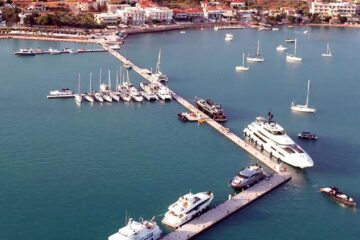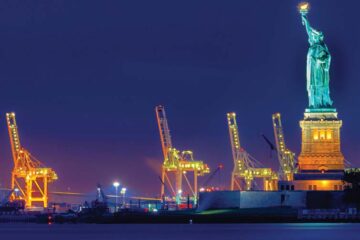Dock building by a Marine Contractor is commonplace. With this comes the installation of Timber Piling, Timber Cross Bracing, Large Structural Timber Wale Systems and more. One of the key tools used when working with these materials is the proverbial Chainsaw. And as most of us are aware, operating a chain saw can be extremely hazardous. Potential injuries can be minimized by using proper personal protective equipment and safe operating procedures.
For starters, one should wear proper clothing that fits snugly and personal protective items before operating a gas-powered or electric chainsaw.
- Safety goggles for eye protection
- Face shield to keep fast moving wood chips away from your face
- Head protection to deflect anything that could fall on you
- Hearing protection as permanent hearing damage can occur from exposure to chainsaw noise
- Safety footwear, such as steel toed work boots or shoes will help protect your feet from falling piling
- Protective chaps and leg guards offer protection against chainsaw operation hazards
- Heavy-duty work gloves and long-sleeved shirts prevent bark and splinters from scuffing your hands and arms
NOTE: Wearing heavy protective clothing can lead to operator fatigue, which could lead to heat stroke. During weather that is hot and humid, schedule your work for the early morning or late afternoon when temperatures are cooler. Take safety breaks regularly.
Before Starting a Chain Saw following are just a few “tips” one might want to follow to prevent a potential on-site accident:
- Check controls, chain tension, and all bolts and handles to ensure that they are functioning properly and that they are adjusted according to the manufacturer’s instructions.
- Make sure that the chain is always sharp and that the oil tank is full.
- Start the saw on the ground or on another firm support. Drop starting is never allowed.
- Start the saw at least 10 feet from the fueling area, with the chain’s brake engaged. Fueling a Chain Saw
- Use approved containers for transporting fuel to the saw.
- Dispense fuel at least 10 feet away from any sources of ignition when performing construction activities. No smoking during fueling.
- Use a funnel or a flexible hose when pouring fuel into the saw.
- Never attempt to fuel a running or HOT saw. Chain Saw Safety
- Shut off the saw or engage its chain brake when carrying the saw on rough or uneven terrain.
Once running, the following are some suggested safety tips.
- Keep your hands on the saw’s handles, moreover, maintain balance while operating the saw.
- Proper personal protective equipment must be worn when operating the saw, which includes hand, foot, leg, eye, face, hearing and head protection.
- Do not wear loose-fitting clothing.
- Watch when cutting ANY Tropical Hardwood Piling such as Greenheart. It is extremely Dense.
- Gasoline-powered chain saws must be equipped with a protective device that minimizes chain saw kickback. Be cautious of saw kickback. To avoid kickback, do not saw with the tip. Keep tip guard in place. Avoid chainsaw kickback: Do not allow the tip of the cutting arm to come in contact with any objects. This can cause a lightning-fast reverse reaction, kicking the guide bar up and back toward the user resulting in serious injury.
- Do not stand on any unstable surface when using the chainsaw, such as Rip-Rap, Ladders, Seawalls, Etc.
- Maintain good balance and footing. Do not overreach or cut above shoulder level.
- Do not operate a chainsaw with one hand. Keep a tight grip with both hands wrapping your fingers and thumbs around the top and rear handles.
- Always remain aware of your surroundings. Keep your work area free of tripping hazards and the cutting arm away from obstructions.
- Run the throttle at full speed. Maintain steady pressure on the cutting arm to the wood being cut. Allow the saw to do the work and do not apply heavy pressure.
- When cutting a Piling that is lying on the ground, let up on the downward pressure as you near the end of the cut. Keep the blade from encountering the ground as this will Dull the blade let alone which could cause personal injury.
Finally, NEVER operate a chainsaw when fatigued or under the influence of medication, drugs or alcohol.









